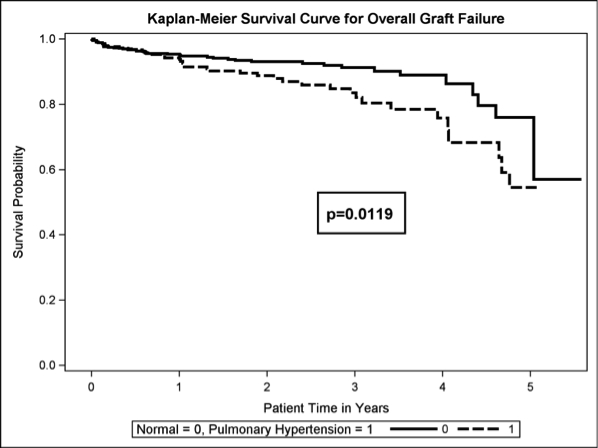Association of Pulmonary Hypertension at Kidney Transplant Evaluation and Subsequent Outcomes Following Transplantation
Y.-L. Lai,1 H. Wasse,2 W. Kim,3 R. Patzer.1,4
1Department of Epidemiology, Emory University Rollins School of Public Health, Atlanta, GA
2Division of Nephrology/Hypertension, Department of Medicine, Northwestern University Feinberg School of Medicine, Chicago, IL
3Emory University School of Medicine, Atlanta, GA
4Department of Surgery, Emory University School of Medicine, Atlanta, GA.
Meeting: 2015 American Transplant Congress
Abstract number: 379
Keywords: Graft failure, Kidney transplantation, Pulmonary hypertension, Survival
Session Information
Session Name: Concurrent Session: Kidney: Cardiovascular and Metabolic
Session Type: Concurrent Session
Date: Tuesday, May 5, 2015
Session Time: 2:15pm-3:45pm
 Presentation Time: 2:39pm-2:51pm
Presentation Time: 2:39pm-2:51pm
Location: Terrace I-III
Background – Pulmonary hypertension (PH) is common among patients with end stage renal disease (ESRD) who depend on dialysis before transplant, and PH is associated with higher mortality rates among ESRD patients. It is unknown the impact of PH on outcomes following kidney transplantation.
Methods – We conducted a retrospective study with data from 638 adult ESRD patients who were medically evaluated and then received a kidney transplant at a major transplant center in the Southeastern US between 2006-2010, with follow-up through 2011. Multivariable Cox models were used to assess whether PH, defined as having pulmonary arterial systolic pressure (PASP ≥ 35 mmHg), was a predictor for overall graft failure (death or graft failure event).
Results – The cohort of patients was comprised of 357 male (56.0%) and 284 white (44.5%) patients, with a mean age of 53.2 years. Out of the 638 transplant recipients, 209 patients (32.8%) had elevated PASP on preoperative echocardiography exam (mean 43.4 ± 9.7 mmHg), with 62 deaths (9.7%) and 55 graft failures (8.6%). Patients with PH prior to transplant had a lower graft survival rate at 5 years vs. patients without pulmonary hypertension (54.6% vs. 76.0%, p<0.05) and were nearly twice as likely to experience overall graft failure (crude HR 1.80, CI: 1.55, 2.08) during the study period [figure] In multivariable analyses, the association was attenuated but PH was still associated with a higher rate of graft failure (adjusted HR 1.30, CI: 1.11, 1.51).
Conclusions – The prevalence of pre-operative PH among kidney transplant recipients is high, and is associated with higher rates of graft failure. Noninvasive screening for PH prior to transplant could be useful to identify patients at higher risk for poor transplant outcomes.
Figure 1. Time to Overall Graft Failure among Patients by Pulmonary Hypertension Status

Table 1. Survival Table among Patients by Pulmonary Hypertension Status

To cite this abstract in AMA style:
Lai Y-L, Wasse H, Kim W, Patzer R. Association of Pulmonary Hypertension at Kidney Transplant Evaluation and Subsequent Outcomes Following Transplantation [abstract]. Am J Transplant. 2015; 15 (suppl 3). https://atcmeetingabstracts.com/abstract/association-of-pulmonary-hypertension-at-kidney-transplant-evaluation-and-subsequent-outcomes-following-transplantation/. Accessed December 24, 2025.« Back to 2015 American Transplant Congress
